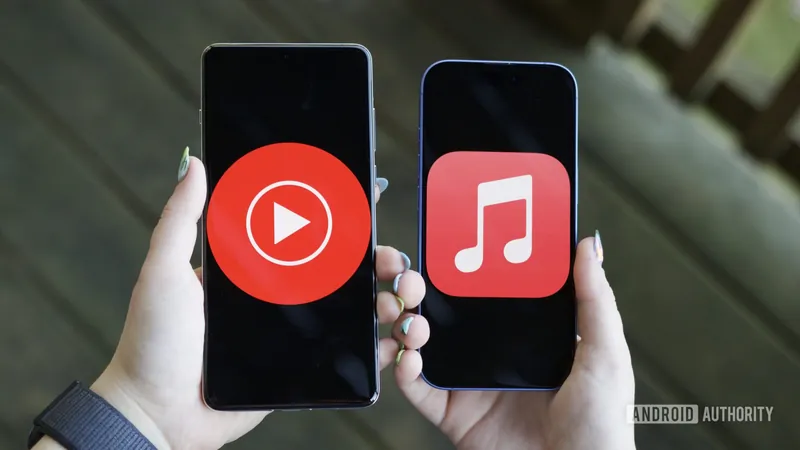
Why I'm Choosing Apple Music Over YouTube Music After Two Weeks of Testing
2025-03-17
Author: Ting
Music streaming services are ubiquitous, with giants like Spotify, YouTube Music, Apple Music, Amazon Music Unlimited, and Tidal vying for our ears. While they all provide similar functionalities, the real difference lies in user experience, music discovery, and subscription pricing.
I've been a devoted Apple Music user for as long as I can remember, building an extensive library and enjoying its seamless overall experience. But recently, I decided to step out of my musical comfort zone and immerse myself in YouTube Music for two weeks. Here’s my experience and why I ultimately decided to return to Apple Music.
What I Liked About YouTube Music:
1. Innovative AI Features: One standout element of YouTube Music is its "Ask Music" feature. This AI tool allows users to input their desired music type, instantly generating a custom station tailored to their request. For instance, I asked for calming coffee shop music focused on acoustic and folk styles and was rewarded with an excellent selection, including tracks from Bon Iver and Tracy Chapman.
2. Robust Music Discovery: YouTube Music offers impressive music discovery tools. Whether looking for new albums or playlists, the app effectively surfaces recommendations tailored to your taste. With well-organized categories and an Explore page showcasing new releases and trends, it’s effortless to find fresh tracks.
3. Value Bundling: The pricing structure of YouTube Music is appealing, especially when bundled with YouTube Premium. For only $14 per month, subscribers enjoy ad-free videos, background playback, and the ability to download both music and videos—a solid deal for anyone consuming content on YouTube regularly.
But Here’s Why I’m Going Back to Apple Music:
Despite its notable features, several issues with YouTube Music made it less suitable for my needs:
1. Lack of Human Curation: While AI-generated playlists can be fun, YouTube Music lacks the human touch. Apple Music trumpets hundreds of playlists curated by human editors, making it easy to find precisely what I want, be it for relaxation or productivity. YouTube Music's equivalent offerings fall short, lacking the depth and variation that come with human insight.
2. Inconsistent User Interface: My frustration started to mount with YouTube Music's "Speed dial" section, which didn’t reliably record my listening history. Unlike Apple Music’s straightforward "Recently Played" feature, YouTube Music often missed tracks and playlists I had played.
3. Podcasts Interference: I prefer my music separate from podcasts. However, YouTube Music’s integration muddied my exploration experience, as recommendations often included podcasts instead of music tracks. This blending of content detracted from my primary focus on music.
4. Audio Quality Deficiencies: As someone who appreciates high-fidelity audio, I found YouTube Music lacking. Apple Music offers Dolby Atmos and lossless audio options for a richer listening experience, whereas YouTube Music's maximum audio quality left me wanting more.
5. Bugs and Glitches: Overall stability is crucial for a streaming service, and my two-week trial with YouTube Music was plagued with bugs, including songs that would get stuck buffering or playback issues that required manual restarts.
In Conclusion:
YouTube Music presents itself as a strong contender in the music streaming market with its innovative features and pricing strategy. However, I found the app experience and deeper human engagement on Apple Music much more aligned with my music listening habits. Therefore, despite my brief adventure with YouTube Music, Apple Music remains my go-to platform for enjoying my favorite tracks.
If you're weighing your options in the ever-expanding music streaming landscape, consider what you value most in an app—curation, audio quality, or perhaps the thrills of AI-generated playlists—and make your choice accordingly!




 Brasil (PT)
Brasil (PT)
 Canada (EN)
Canada (EN)
 Chile (ES)
Chile (ES)
 Česko (CS)
Česko (CS)
 대한민국 (KO)
대한민국 (KO)
 España (ES)
España (ES)
 France (FR)
France (FR)
 Hong Kong (EN)
Hong Kong (EN)
 Italia (IT)
Italia (IT)
 日本 (JA)
日本 (JA)
 Magyarország (HU)
Magyarország (HU)
 Norge (NO)
Norge (NO)
 Polska (PL)
Polska (PL)
 Schweiz (DE)
Schweiz (DE)
 Singapore (EN)
Singapore (EN)
 Sverige (SV)
Sverige (SV)
 Suomi (FI)
Suomi (FI)
 Türkiye (TR)
Türkiye (TR)
 الإمارات العربية المتحدة (AR)
الإمارات العربية المتحدة (AR)